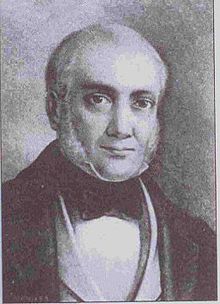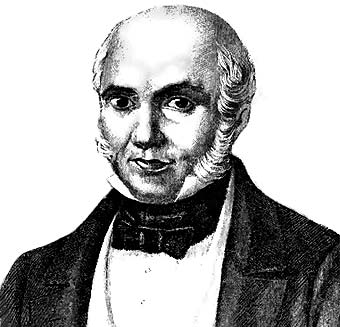Braulio Carrillo Colina
Braulio Carrillo Colina Evaristo (* March 20, 1800 in Cartago, Costa Rica, † May 15, 1845 in San Salvador, El Salvador) was from May 1835 to February 1837 and from May 1838 to April 1842 head of state of Costa Rica.
Life
His parents were María de Jesús Colina Gutiérrez and Benito Carrillo Vidamartel.
Carrillo studied law at the University of León ( Nicaragua).
Braulio Carrillo Colina was president and judges of the Supreme Court [ wp 1].
In 1828 he was a Member of the Parliament of the Province of Costa Rica, where he was a short time President of the Parliament. From 1834 he was a Member of the Parliament of the Central American Confederation in San Salvador.
Jefe de Estado
Rafael Luis José de Gallegos y Alvarado handed in his resignation in March 1833. From June 1834 to March 4, 1835 was representative Agustín Gutiérrez Lizaurzábal for Gallegos, Executive Jefe de Estado. The Parliament adopted on 4 March 1835 and revoked his resignation on March 6, 1844 he was elected president. With the acceptance of the resignation was from 4 to March 18, 1835 Juan José de Lara y Arias from Salamanca ( * 1780) Jefe de Estado. From March 18 to May 5, 1835 was Manuel José Fernández Chacón Jefe de Estado managing. On March 6, 1835 as the Parliament revoked the election of Gallegos was so that his deputy also canceled. On May 5, 1835 Braulio Carrillo Colina Jefe de Estado Evaristo was.
In September and October 1835, the Guerra de la Liga took place.
In 1836 he declined the holidays. 1836 saw the Braulio Carrillo Colina Government attacked by costa rice Saxon migrants from Nicaragua. His government promoted the cultivation of coffee.
In the elections for Jefe de Estado 1837 Braulio Carrillo Colina was a candidate, was elected Manuel Aguilar Chacón.
Braulio Carrillo Colina Manuel Aguilar Chacón crashed in May 1838 a coup. After he had broken the existing constitution, he called for a Constituent Assembly. This Constituent Assembly declared in November 1838, the separation of Costa Rica from the Central American confederation. The Constituent Assembly interrupted their meetings in December 1838 so that works out a new constitution, a commission, when the new constitution was present in April 1839 occurred not more together this Constituent Assembly.
As 1840 José Francisco Morazán Quezada with the schooner Izalco after losing to José Rafael Carrera Turcios made in Costa Rica station, Carrillo was some liberals from the wake of Morazán asylum. These included Pedro José Antonio Molina Mazariegos, whose son, Felipe, José Irungaray, whose son Manuel Irungaray, Carlos Salazar Castro, the priest Isidro Menéndez [ wp 2], the generals Enrique Rivas and Indalecio Cordero, José Miguel Saravia, Nicolás Espinoza, the Supreme Gerardo Barrios, Máximo Cordero, Mariano Prado Baca and Capitán José María Cañas Escamilla [ wp 3]. Later came Doroteo Vasconcelos Vides, who went back soon and Lieutenant Colonel Manuel Ángel Molina Bedoya [ wp 4]. Carrillo gave these exiles sometimes high positions of trust. Menéndez he commissioned with the editors of administrative rules. Felipe Molina, Menéndez, Filadelfo Benavente and Joaquín RVAs he commissioned in the state so that a police, a regulatory law and a judicial system build. Enrique Rivas he entrusted with the command of Puntarenas, Lieutenant Colonel Molina he gave the command of Guanacaste. The Directorate of Police he was Lieutenant Colonel Pardo. The commandant of Moin he stated Capitán José María Cañas. On the assurance of Colonel Vicente Villaseñor he was from the state budget 2,000 pesos to Gerardo Barrios, so this should create an indigo plantation in Hacienda Las Alajuela which aim at introducing this plant in Costa Rica.
1841 decreed Braulio Carrillo Colina a Ley de Garantías with which he confirmed his dictatorial role for life as necessary for the development of Costa Rica.
The many enemies of Carrillo called Morazán about General Pedro Bermúdez of Peru. Morazán embarked in March 1842 in Valparaíso on board the Coquimbo one. Morazán sailed the brig El Cruzado on Chiriquí, Panama.
On April 7, 1842 Morazán reached the bay of caldera 30 kilometers south of Puntarenas with the ships Cruzador, Asución, Granadia, Isabel II, Josefa and Cosmopolita. They came from the island of Isla Martín Péres in the Gulf of Fonseca. Morazán was of 400 soldiers and the generals Isidoro Saget, José de la Trinidad Francisco Cabañas Fiallos, José Miguel Saravia, Máximo Cordero, Nicolas Espinosa, Francisco Ignacio Rascón ( Rascou ), Joaquín Rivera Braga, Colonel Blas Brusual, Colonel Alejandro Escalante accompanied Lieutenant Ceferino Escalante.
As Carrillo learned of the invasion he gave the presidency to Manuel Antonio Bonilla Nava [ wp 5] from his deputy, leaving her Colonel Vicente Villaseñor [ wp 6] countered with nearly 1,000 men. Villaseñor and Morazán agreed on 11 April 1842 in Jocote Guanacaste.
Carrillo went into exile in El Salvador, where he was killed.
The Parque Nacional Braulio Carrillo [ wp 7] is located between the provinces of Limón and San José
On March 28, 1987, the Autopista Braulio Carrillo which San José Limón, connects opened.




.jpg)




